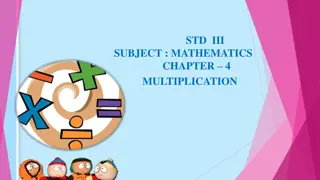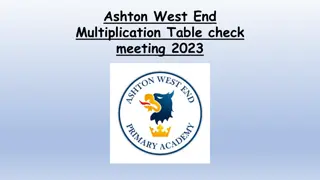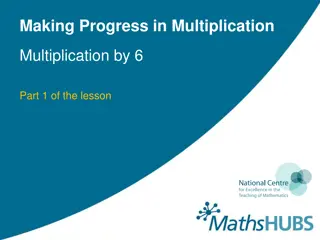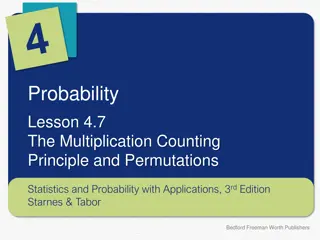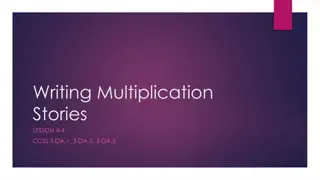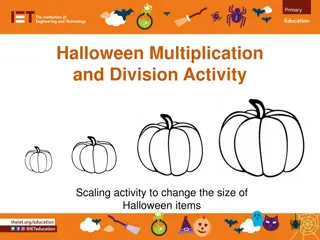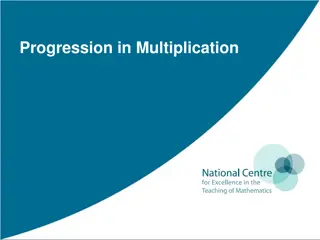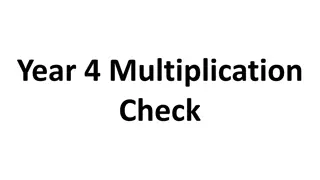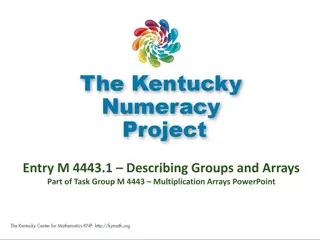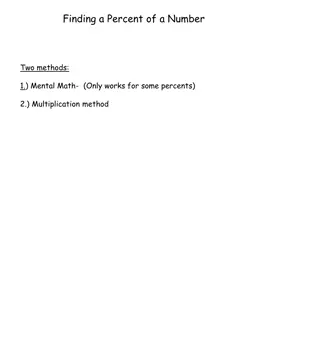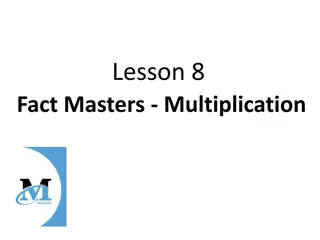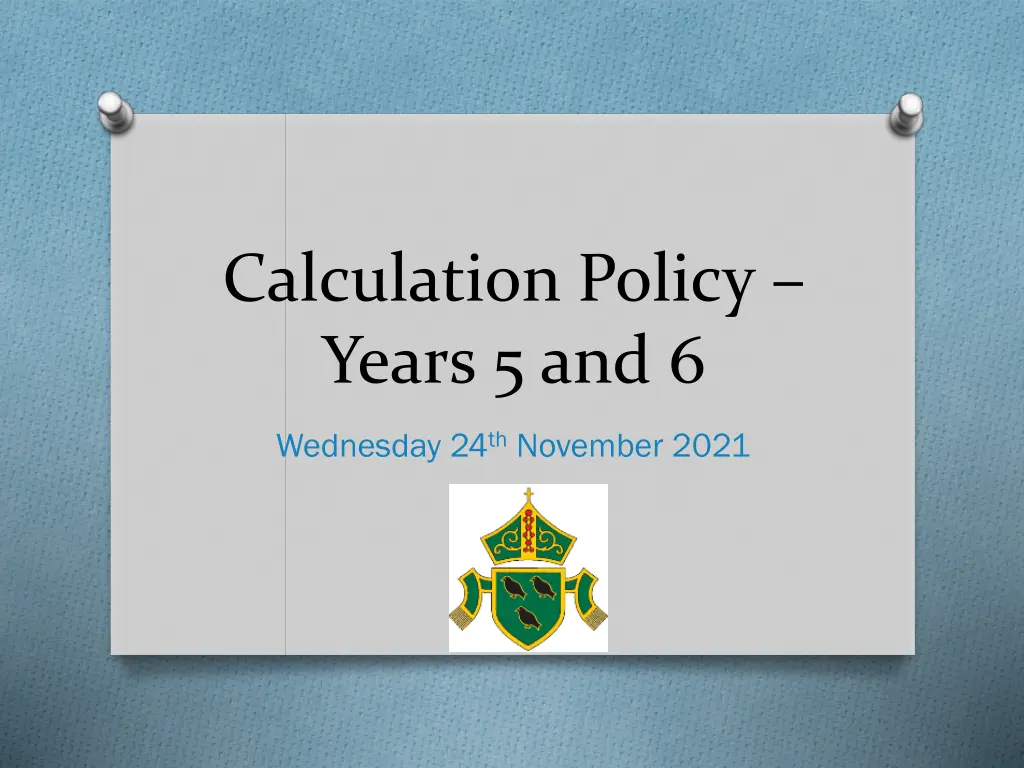
Understanding Multiplication Strategies: Grid Method Mastery
Explore the effective grid method for mastering multiplication strategies, including tips for multiplying by ten and progressing through times tables efficiently. Enhance your math skills with visual aids and step-by-step techniques.
Download Presentation

Please find below an Image/Link to download the presentation.
The content on the website is provided AS IS for your information and personal use only. It may not be sold, licensed, or shared on other websites without obtaining consent from the author. If you encounter any issues during the download, it is possible that the publisher has removed the file from their server.
You are allowed to download the files provided on this website for personal or commercial use, subject to the condition that they are used lawfully. All files are the property of their respective owners.
The content on the website is provided AS IS for your information and personal use only. It may not be sold, licensed, or shared on other websites without obtaining consent from the author.
E N D
Presentation Transcript
Calculation Policy Years 5 and 6 Wednesday 24thNovember 2021
Times Tables By the end of Year 4, all children should be confident with all times tables up to 12 x 12, and the corresponding division facts. Suggested order for learning tables: 10x, 5x, 2x, 4x, 8x, 3x, 6x, 9x, 7x, 11x, 12x
Multiplying by ten When multiplying by ten, it is vitally important that children are not told to just add on a zero.
Multiplying by ten When multiplying by ten, it is vitally important that children are not told to just add on a zero. 3 x 10 = 30 BUT WE DID NOT JUST ADD A 0! If you add a 0, that means 3 + 0 = 3
Multiplying by ten H T O
Multiplying by ten H T O 7
Multiplying by ten H T O 7 7
Multiplying by ten H T O 7 7 0 seven tens = 70
Stage 3 The Grid Method The Grid Method is reliant on a solid knowledge of times tables. Draw a grid as shown on the left. Partition the thirteen into one ten and 3 ones. Place the 8 at the side and a multiplication symbol (x) in the top left hand corner. Work out 10 x 8 (80) Work out 3 x 8 (24). 80 + 24 = 104 13 x 8 = 104 13 x 8 = 104
Stage 3 Continuation of the grid method Some children will prefer to break the 20 down into two tens, therefore working out: (10 x 8) (10 x 8) (3 x 8) 23 x 8
Stage 3 Further use of the grid method, for TO x TO 23 x 28 23 x 28 400 + 60 = 460 160 + 24 = 184 460 + 184 = 644
Over to you: Try using the grid method to find the answer to one of these multiplications: 36 x 3 54 x 6 37 x 24
Stage 3 into Stage 4 The grid method is a popular and effective way of multiplying. It plays on knowledge of partitioning, draws on known facts and demonstrates what happens when you multiply by 10 or by 100. It also highlights how many multiplication actions need to take place when working with long multiplication. For 23 x 28, four multiplications need to be undertaken, shown clearly in each cell in the grid. All of the elements of this approach are the same as those needed in the standard method, but in the grid method they can be seen and you can easily tell if one of the multiplications has not taken place.
Stage 4 Partitioned Vertical Multiplication 47 Step 1 set the calculation out as you would for using the traditional vertical method. x 8
Stage 4 Partitioned Vertical Multiplication 47 Step 2 multiply the one on the top line by the one on the bottom line. x 8 56 (7 x 8)
Stage 4 Partitioned Vertical Multiplication 47 Step 3 multiply the ten on the top line by the one on the bottom line. x 8 56 (7 x 8) 320 (40 x 8)
Stage 4 Partitioned Vertical Multiplication 47 Step 4 add each column together Ones (6 + 0) Tens (50 + 20) Hundreds (0 + 300) x 8 56 (7 x 8) 320 (40 x 8) 376
Stage 4 52 x 17 14 (2 x 7) 20 (2 x 10) 350 (50 x 7) 500 (50 x 10) 884 The previous method can be extended for TO x TO
Over to you: Try using partitioned vertical multiplication to find the answer to one of these multiplications: 63 x 8 36 x 23
Stage 4 into Stage 5 Applying concepts taught through the grid method to a vertical layout prepares children for using the formal vertical method for multiplication.
Stage 5 4 7 x 8 Step 1 multiply 7 by 8. This gives 56. Place the one (6) in the ones column, and the ten (5) under the tens column. 5 6
Stage 5 Step 2 multiply the 8 by the 4 tens. This gives 32 . Add the carried 5 onto the 32 (37) and place in front of the 6 ones. 4 7 5 x 8 3 7 6 This gives an answer of 376.
Stage 5 Going further 256 x 18 Follow the same method shown previously, to multiply the 8 ones on the bottom line by the top number. Ensure that carried digits are added onto the total. 256 2048 x 18 4 4
Stage 5 Going further 256 x 18 Then, multiply the ten on the bottom line by the digits on the top line. As you are multiplying by a ten , ensure that a zero is placed in the ones column before starting the calculations. 256 2048 4 4 2560 x 18
Stage 5 Going further 256 x 18 Add the columns in each row together. Again, ensure that the carried digits are added to the total as you make your way across. 256 2048 2560 4608 x 18 1
Over to you: Try using the formal method of multiplication to find the answer to one of these calculations: 142 x 7 342 x 16 435 x 28
Why not go straight into vertical methods? The formal method holds many opportunities for errors (incorrect lining up of columns, forgetting about carried tens/hundreds etc). Lack of understanding of size of numbers, therefore reasonableness of answers (using a number line earlier on helps to grasp a secure understanding of the number system). Recognising when calculations are better carried out mentally, as opposed to a single reliance upon one method. Understanding more than one method means that a calculation can be checked without the same error being included.


